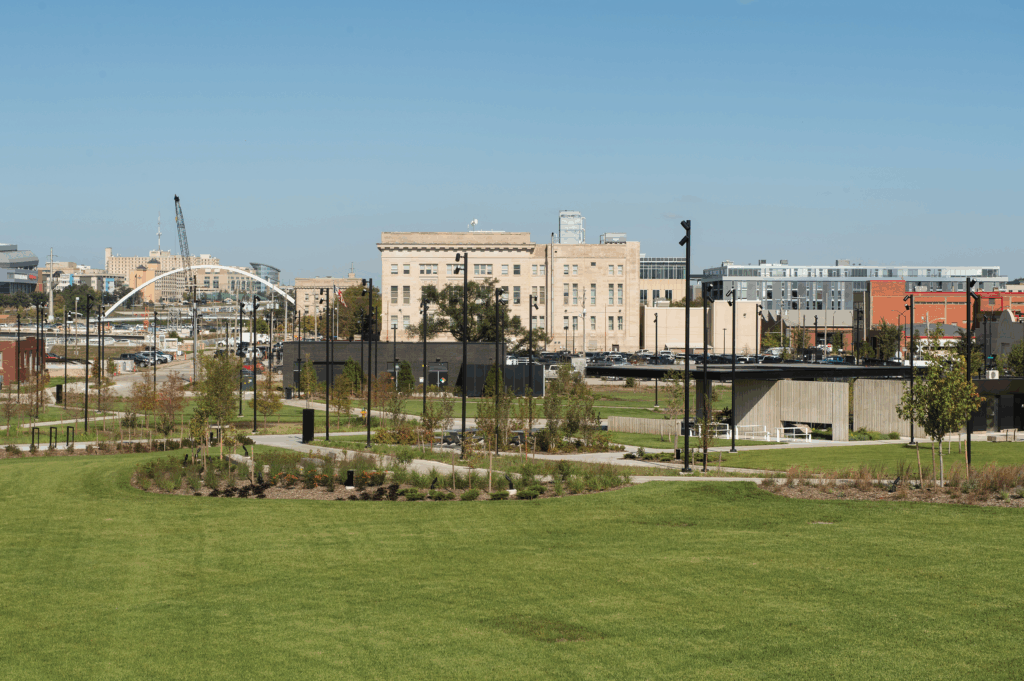‘Des Moines has been discovered’ in national CRE market

KENT DARR Mar 7, 2018 | 11:31 pm
6 min read time
1,445 wordsAll Latest News, Real Estate and DevelopmentFor owners of apartment buildings and office and retail spaces in Greater Des Moines, it’s time to get creative, and sure enough, some have already heard the message, according to the folks at CBRE|Hubbell Commercial.
There is a caveat: Don’t interpret the message to mean it’s time to fret those markets, according to CBRE|Hubbell Commercial representatives who recently discussed the firm’s annual survey of the commercial real estate market.
“The common theme is the fundamentals are strong,” said Kyle Gamble, managing broker at CBRE|Hubbell Commercial. “Population growth and job growth lead other markets in their class; that trickles down to our real estate sector in a very positive way. You are seeing activity in all sectors.”
The reports quantified what many had predicted. With an estimated 3,230 apartment units landing on the market last year, vacancies have risen to 6.7 percent across the metro and were up nearly 10 percent in downtown Des Moines. Another 3,061 are under construction, according to the multifamily report.
As a result, rent increases will stabilize and development of new apartments will slow before the market tightens again, possibly in the next two to three years.
The effect of an increase in the vacancy rates has been a boom in incentives for renters, an effort to increase the amenity packages found in new apartments — that’s the creative thinking at work — and a rethinking on the part of some developers for the delivery date of new projects.
Hubbell Realty Co. President and CEO Rick Tollakson has said his company is not fretting the delivery of apartments this year, provided they are available in the spring.
Kris Saddoris, the company’s vice president of development, and Alexander Grgurich, a partner with Nelson Construction & Development, said during interviews earlier this year with the Business Record that the increase in vacancies downtown is a plus, providing choice for renters who once turned to the suburbs after finding apartments downtown full the day they opened.
It should be noted that CBRE|Hubbell Commercial released its market report on Tuesday, the same day Hubbell Realty unveiled plans for a mix of for-sale units in the company’s Gray’s Station development. The goal is to keep renters downtown when they decide to become owners.
Amenities could come in the form of reducing apartment footprints and increasing the size and variety of common areas. Linda Gibbs, CBRE|Hubbell Commercial senior vice president for investment properties, said that in some markets apartments are reduced to a bedroom and bathroom with common kitchens and living areas.
Developers have looked at the glut of apartments and sought alternatives for some of their projects. The development team that brought a new parking ramp in the East Village near Des Moines City Hall had the option to bring some mix of residential, office and retail to a building that will be the first of two that will flank the ramp. They opted for office and retail in a unique building that will bring heavy timber construction back to the city and state for the first time in 100 years.
The construction materials — laminated lumber for the superstructure and charred wood cladding — will help entice tenants, especially “tech-driven” companies, said Tyler Dingel, senior vice president for CBRE|Hubbell Commercial. “I have a client who would move in today, but the building is a year out” from delivery, he said.
Nelson Construction & Development has altered its initial plans for an apartment building at a redevelopment parcel at Seventh Street and Grand Avenue to include an office building first, followed by construction of an apartment building.
Those office buildings will enter a market “where the demand for office space remains strong” and has led to the construction of speculative office buildings and renewal of older offices.
The report characterized 2017 as the “year of shifting,” with tenants moving out of older space to new space, often in buildings that have been renovated to the renters’ expectations.
Dingel sees a change in the tendency to shift.
“I’m starting to see companies that are growing in size or bringing in new lines of business or expanding lines of business,” he said. Office users are “slowly taking up space at an Iowa pace, slow and steady.”
Landlords need to be prepared to freshen up their older buildings to provide a good first impression for prospective tenants, Gamble said. That renewal includes lobbies and other common areas.
“The office side has been a landlord’s market,” said Bill Wright, a CBRE|Hubbell Commercial senior vice president and managing director. “I see that changing in 2018, 2019.”
Tenants, from those needing 4,000 square feet to larger users wanting 25,000 square feet or more, are going to have more options, especially with the freeing up of large amounts of space as big users move to newer buildings.
“That is going to lead to more competition from a landlord perspective and probably a better deal for the tenant,” Wright said. “All of these markets cycle, and I think we’re at that point in the cycle. We have more options.”
Owners of second-generation office buildings in the suburbs will have to compete with downtown offices by offering what “millennials are looking for,” Gibbs said. What they are looking for is walkability, healthy food options, fitness centers, an “experiential” work environment.
And that experiential environment is what office and retail have in common. Greater Des Moines experienced a decline in retail vacancies among big-box retailers — stores of 25,000 square feet or more — and neighborhood shopping centers, with a total of 380,000 square feet of retail space filling up last year, according to the report.
The Jordan Creek Town Center area in West Des Moines and Prairie Trail and Delaware Avenue in Ankeny continue to be strong destinations for retailers, with Jordan Creek and Prairie Trail also attracting a fair number of office users.
But any retailer with a street presence needs to provide an experience to get customers in the door and keep them there for more than 10 minutes, Dingel said. Those experiences can include climbing walls, dining, drinking, fitness options, attractions. It isn’t just about shopping.
“The retail shops are saying to the owner, ‘What are you doing to help drive traffic, and how are you going to keep them here?’ “
The report found a growing divide in the retail market between Class A retail locations and second-generation centers.
“The Class A centers are often newer construction and characterized by high visibility, superior co-tenancy, limited supply and higher rental rates. On the other hand, there is a supply of inferior retail space that is often unanchored, located in mature retail corridors with limited growth, flat rental rates and excess supply,” according to the report.
To make those second-generation centers viable, owners often fill vacant spaces with nonretail users such as medical tenants or spend a substantial amount of money on renovations.
One example of creative thinking cited was Urban Town Center in Urbandale, a neighborhood center that was renamed after its purchase by Signature Real Estate Services, which also added new facades, landscaping and signage, among other things.
“For those of us who make a living brokering retail space, it’s all about creativity,” Wright said.
Rental rates in the western suburbs have risen to the mid-$30s per square foot or higher for Class A centers, whereas retail space can be leased just a few miles away in the $10-$14 range at inferior centers, according to the report.
Industrial space — manufacturing, warehousing, distribution centers, flex space that provides a range of uses — is the darling of investors and possibly the hottest of the commercial real estate sectors.
“In our market, industrial is at the very early stages of satisfying just-in-time delivery,” Gamble said. “Industrial will see the impact of omnichannel phenomena,” where online retailers have a brick and mortar store. “This market is primed for further growth in the distribution sector.”
A separate report from Gibbs and Timothy Sharpe, a CBRE|Hubbell Commercial senior vice president for investment properties, showed that commercial real estate sales in Greater Des Moines increased 38 percent last year to $434 million. National sales dropped 7 percent to $464 billion.
Sales were strong in “every size and category,” Gibbs said, with several large multifamily sales helping to drive the overall numbers.
Gibbs said buyers from “all over the country” are eyeing Greater Des Moines.
“Des Moines has been discovered,” Sharpe said.
The report on the multifamily market was prepared by CBRE|Hubbell Commercial and Commercial Appraisers of Iowa, Inc. The West Des Moines-based brokerage and Frandson and Associates prepared the industrial, office and retail surveys.
The full reports are available by clicking these links: Multifamily, Industrial, Office, Retail.









